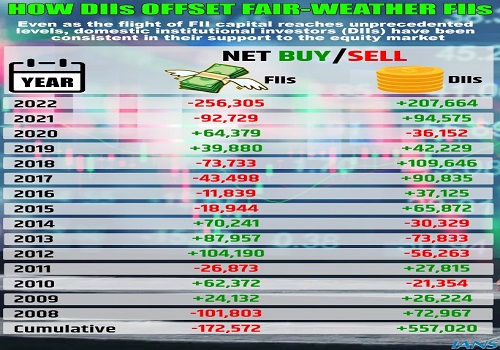Domestic funds fuelled by retail investors matching FII selling

Follow us Now on Telegram ! Get daily 10 - 12 important updates on Business, Finance and Investment. Join our Telegram Channel
FIIs or FPIs used to be the mainstay of Indian capital markets and their trading or investing decisions dictated the way markets moved. They have been around in the country for a little over 30 years and we have seen how markets moved with their buying and fell with their selling. We learnt what Dow meant, Dow futures meant and impact of FED rate hikes. Sometime ago at a similar time, they learnt kerb trading and what the impact of that was on Dalal Street.
Today the size, scale and players have changed completely. FIIs and FPIs, who were the only dominant players as they primarily were in just the top 500 stocks, are no longer in the pole position.
While their participation in the stock does impact prices, they are being increasingly matched by the domestic institutions who have grown in clout and have a much bigger role to play. The current AUM of the domestic mutual funds industry is about Rs 37.22 lakh crore. This does not include the now listed LIC which has an AUM of roughly 40 lakh crore.
This large AUM of domestic funds is funded by an active investor base who has been investing regularly through the SIP route. The average monthly SIP collection has increased steadily by Rs 8,000 crore monthly in FY 2020-21 to 10,000 crore in FY 2021-22 and in the first two months of the current financial year 2022-23 to Rs 12,000 crore.
This augurs well for the domestic mutual fund industry. The folio base of SIP investors is a large 5.48 crore investors indicating the depth and the fact that this is not going to stop in the near future.
The demat accounts in the country have now touched 9.47 crore and around the pre-Covid time of March 2020, they were under 5 crore level. This indicates that stay at home and the fact that equity levels had touched rock bottom levels did induce individuals to become investors. Their confidence has been rightly justified.
Let us look at the table in the article. For the first 10 years, the net figure by either the FIIs or FPIs and the counter figure from Domestic institutions were not very large on an annual basis. The year 2008 saw the global debt crisis and naturally FIIs would be sellers. From 2012 to 2014, FIIs were net buyers and domestic funds were net sellers, helping them to get their stock. And from 2015-2018, FIIs were sellers but not very large and domestic funds were buyers, at times aggressive.
In 2019, both were buyers, the second time in 10 years after 2009. In 2020, FIIs were buyers while domestic funds sold. In 2021, FPIs sold Rs 92,000 crore while Domestic funds bought slightly more at Rs 94,000 crore. 2022 has been one sided with FII's selling aggressively and have already sold over Rs 2.67 lakh crore as of Friday (updated from table). This is just in five months and a half. Domestic funds have tried to keep pace and have bought Rs 2.15 lac crore as of Friday (updated from table).
Inflation in the US is at a more than 40-year high and is becoming a major cause of concern for the country and the globe. The US FED has during the course of the last week raised interest rates aggressively at 75 basis points and hinted at another similar rise in July end at the next FED meeting. Interest rates which were zero are already at 1.75 per cent at the top end of the band and would be 2.5 per cent by July end.
With the balance sheet also being contracted, funds are becoming expensive. Global markets are under pressure. FIIs are forced to reduce their exposure and they are selling aggressively in India as this is one market where they are making handsome profits even today. On a broad basis, markets are still double the values reached at the low of March 2020. They are getting a fairly easy exit with domestic mutual funds buying what is on offer.
One wonders why domestic funds do not stop buying for some time and let FIIs sell as much as they desire. Not sure whether that would be the right way of looking at things as FPIs would wait for markets to bounce and then sell. Probably their urge to sell should be allowed to be done with.
The future scenario at hazarding a guess. FII's at some point would have sold all that they needed to sell. Having completed the first part and realising that India has the ingredients for a bull market rally, they would look at India as an investment destination. The stock would be available with just the domestic institutions. Could cause a short squeeze and take markets up. One way of looking at things and hopefully things would play out. When and how soon? Not sure.
A small point to be kept in mind is that the Dow Jones and Indian Indices are all at a 52-week low.












 320-x-100_uti_gold.jpg" alt="Advertisement">
320-x-100_uti_gold.jpg" alt="Advertisement">












